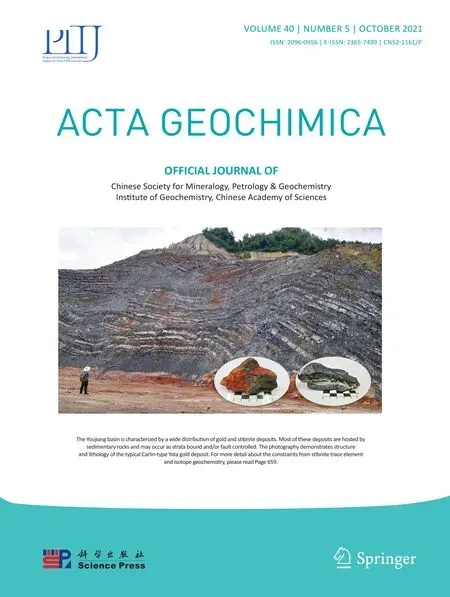Source characteristics and genesis of Sb mineralization from the Au and Sb deposits of the Youjiang Basin,SW China:constraints from stibnite trace element and isotope geochemistry
Aizat Zhaanbaeva·Keqiang Peng·Abiola Oyebamiji·Kyiazbek Asilbekov
Abstract The Youjiang Basin is characterized by a wide distribution of Au and Sb deposits.These deposits are mainly hosted by sedimentary rocks from Cambrian to Triassic and are structurally controlled by faults and folds.Three types of Sb mineralization can be distinguished based on geologic characteristics,economic metals,and mineral associations.The f irst type is dominated by Sb mineralization but contains minor or little Au,similar to the large Qinglong deposit.The second type has a spatial association with the gold deposit but formed independent Sb mineralization,reminiscent of the Badu deposit.In the third type,Sb generally formed as an accompanying element in the Carlin-type gold deposit,and stibnite occurred as euhedral crystals f illing the open space and faults in the late stage of gold mineralization,analogous to the Yata deposit.Trace element concentrations and sulfur isotopic ratio of stibnite,and oxygen isotope of stibnite bearing quartz were analyzed to infer the ore source(s)for Sb mineralization and genesis.To distinguish the various types of stibnite mineralization between the deposits,Cu,Pb,and As have recognized most diagnostic,with an elevated concentration in Au and Au-Sb depositsand depleted in Sb deposit.Theδ34S isotopic composition of stibnite samplesfrom threedepositsshow awidevariation,ranging from-6.6‰to+17.45‰.Such isotopic values may indicatethesedimentary sulfur source,introduced by f luidrock interaction.On the other hand,f luid mixing of several end members cannot be excluded.The calculatedδ18O isotopic data of Sb-bearing quartz show the initial ore f luid in Au and Au-Sb deposits most likely have a magmatic or metamorphic origin that enriched during f luid-rock interaction,and Sb deposit characterized by initial meteoric water.From these data,we proposed that different lithologies,f luid-rock interaction,f luid pathways,and different ore f luids controlled the compositional evolution of f luids,which might be the main reason for the diversity of Au or Sb mineralization.
Keywords Trace elements·Stable isotope·Sb mineralization·Youjiang Basin·SW China
1 Introduction
Antimony is currently recognized as a critical material for modern society.Globally,the primary production of antimony is now isolated to a few countries and is dominated by China(Anderson 2012),which supplies the world with 92%of all f inished antimony products.The word antimony(from the Greek anti plus monos)means‘‘a metal not found alone’’,and is seldom found in nature as a native metal because of its strong aff inity for sulfur and metals such as copper,lead,and silver(Anderson 2012).Industrially,stibnite(Sb2S3)is the predominant ore mineral of antimony,usually found in quartz veins and stable over a wide range of physicochemical conditions commonly encountered in nature(Williams-Jones and Normand 1997).
The Xiangzhong Sb-Au and the Youjiang Au-Sb-Hg domains,located at the southwestern part of the Yangtze Block,China,and making up the giant South China lowtemperaturemetallogenic domain together with the Chuan-Dian-Qian Pb-Zn domain,provide over 50%of the Sb reservesof theworld(Hu et al.2017).Among these,the Sb reserves in Xiangzhong Basin has been proven to over 2.7 Mt(Peng et al.2014),and two types of Sb deposits have been classified:independent Sb deposit occurring in the cover strataof Late Paleozoic,and Sb-Au deposit occurring in the basement(Ma et al.2002;Hu et al.2017),e.g.the world’slargest Xikuangshan Sb and the large Woxi Au-Sb deposits,respectively.
In contrast,the Youjiang Basin is predominantly characterized by the wide distribution of Carlin-type gold deposits with proven gold reverse over 800 t(Hu et al.2017;Su et al.2018),and Sb commonly occurs as the accompanying element of Au in these deposits.However,several important Sb deposits are also formed in thisbasin,which is mainly hosted by sedimentary rocks from Cambrian to Triassic and structurally controlled by faults and folds.
Preliminary geochronological works revealed the Sb depositsor Sb mineralization in thebasin areformed at 148 to 134 Ma,suggesting they shared a similar setting,and are contemporaneouswith Carlin-type gold mineralization.For example,f luorite intergrown with stibnite in the Qinglong deposit has yielded Sm-Nd isochron age of 148 Ma(Peng et al.2003).Hydrothermal quartz veins that contained variably realgar and stibnite in the Yata deposits have obtained Rb-Sr isochron age of 148 Ma(Jin 2017).Similarly,hydrothermal rutile and monazite in the Badu gold deposits have also yielded U-Th-Pb ages of 144 to 141 Ma(Gao et al.2021).
Compared to the Carlin-type deposits in the basin,however,these low-temperature stibnite deposits have drawn much less attention(Chen et al.2018;Li et al.2019),the metal and f luid sources,as well as the genesis,remain controversial.Importantly,the mechanism and processresulting in thedistribution of theelements,and the key factors controlling the similarity and differences of Sb mineralization,e.g.primary ore-forming f luids,physicochemical parameters,and f luid-rock interaction,remain debatable.On the other hand,the comparative studies with the Sb and Sb-Au deposits in the Youjiang Basin are scarce.
Because stibnite(Sb2S3)is the predominant ore mineral and shows intimate paragenesis relationships with hydrothermal quartz.Thus,we used stibnite trace element and sulfur isotope geochemistry,and oxygen isotope geochemistry of stibnite bearing quartz,from Yata Au,Badu Au-Sb,and Qinglong Sb deposits of Youjiang Basin,to clarify,the ore source for mineralization and genesis.
2 Geological background
2.1 Regional geology
The South China Block is an important metallogenic province that formed as a result of the combination of the Yangtze Craton and Cataysia Block along Jiangshao suture zone and bordered by the North China Craton from the north and Indochina Block from the west.
The Youjiang Basin coverstheterritory about 50,000 m2and becomes an important Au-As-Sb-Hg region of the southwestern part of the South China Block.It is bounded by the Mile-Shizong Fault to the northwest,the Shuicheng-Ziyun-Bama Fault to the northeast,and the Red River Fault to the southwest(Fig.1;Hu et al.2017).Many studies have documented that the Youjiang Basin lies on a basement of Lower Paleozoic strata and evolved into three stages,started from the passive continental margin rift basin-between Early Devonian to Early Permian,subsequent back-arc basin formation-from Late Permian to Early Triassic,followed by foreland basin formation-from Middle to Late Triassic,consistent to the opening,subduction and closing of Paleo-Tethys ocean(Zeng et al.1995;Gu et al.2012;Chen et al.2015;Hu et al.2017).The sedimentary strata are mainly composed of marine sediments with a~7 km thick sequence(Song et al.2009;Galfetti et al.2008;Yang et al.2012).The overlying sediments from Devonian to Early Permian are mainly composed of carbonates,mudstone,sandstone,and chert.
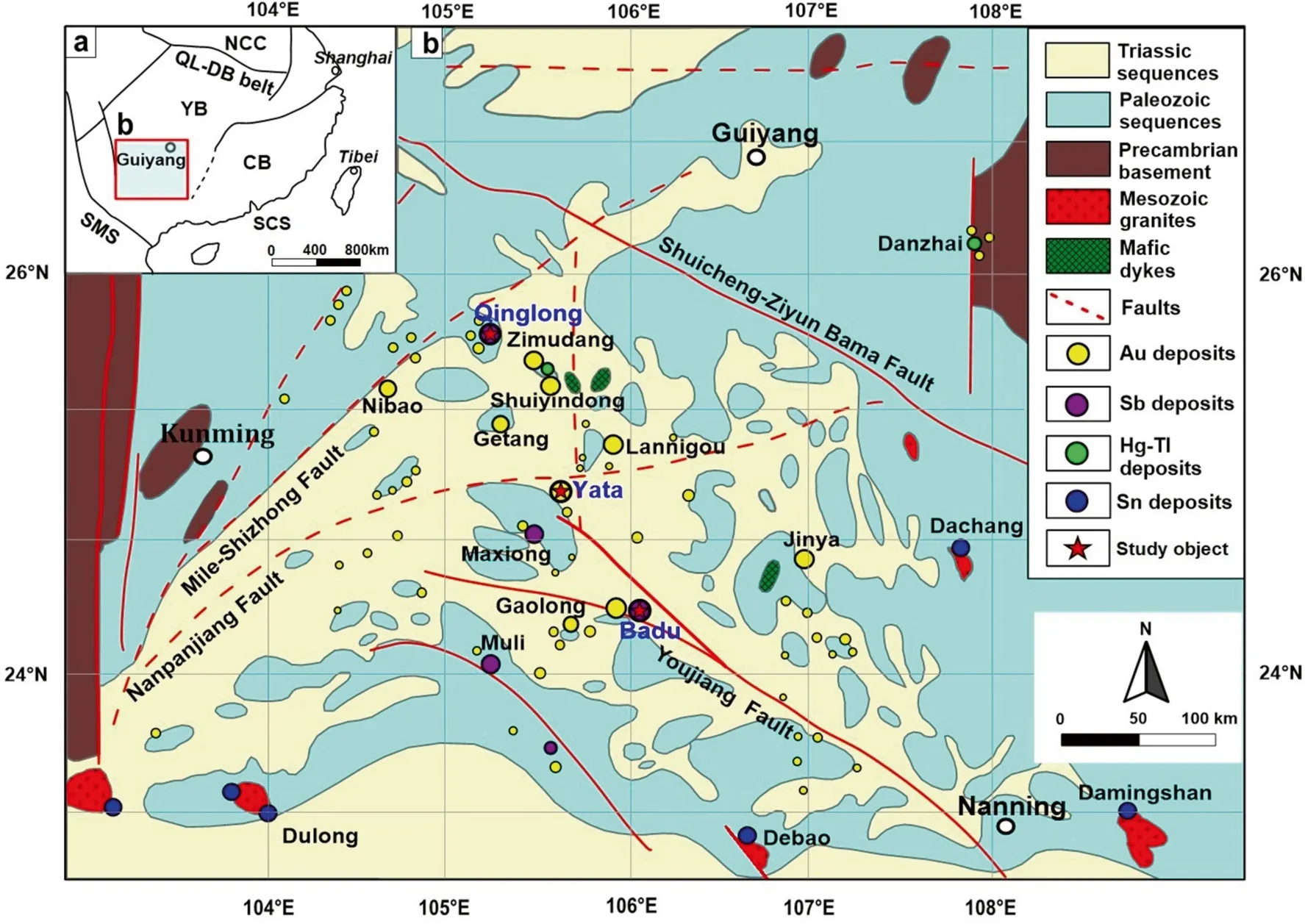
Fig.1 Geologic map of Youjiang Basin in SW China(modified after Hu and Zhou 2012)and location of Yata,Badu,and Qinglong deposits
The rifting process accompanied by strong volcanic activity occurred at the beginning of Late Permian that became a reason for the distribution of‘‘Emeishan basalts’’in the western part of the basin.Early-Middle Triassic time was described with the deposition of mudstone-sandstone turbidite and a large number of volcanic materials in the southern part of the basin(Liu et al.1993;Feng and Bao 1994).The Youjiang Basin was closed at the end of the Middle Triassic with strong compressional deformation.Many of theformer growth faultsthen becamethrust faults.Sedimentary rocks were folded in different directions,narrow and steep folds developed in depression facies units,broad and gentle folds in platform facies units.Extraordinary strong deformation(including folding,fracturing,and faulting)occursalong thecontact zone between thetwo faciesaround theisolated submarineplatforms(Liu et al.2016).Indosinian(ca.215 Ma)and Yanshanian(ca.90 Ma)granites are distributed in the southern and eastern parts of the basin(Hu et al.2017).
Numerous Au and Sb ore deposits,with the spatial and temporal relationship,are distributed in the Youjiang Basin.Several hundreds of Carlin-type Au deposits and occurrences have been discovered within the basin.Those deposits are hosted mainly in the Permian and Triassic strata and occur as strata-bound(Shuiyindong,Taipingdong,Zimudang,Getang,Nibao,etc.),and the fault-controlled ore deposits(Lannigou,Yata,Banqi,Zimudang,etc.;Wang et al.2012).Antimony ore deposits occur mainly in strongly silicified limestones and brecciated claystoneand siltstonesnear theunconformableboundaries and fault zones(Qinglong,Maxiong,etc.)and only a few Au-Sb associated ore deposits(Badu)have been found(Wang et al.2012).
2.2 The Yata Au deposit
The Yata gold deposit is located at 15 km southwest from the Ceheng county in southwestern Guizhou(24°54′46‘‘N,105°39′11’’E),in the south of Nanpanjiang regional fault,on the center of Youjiang Basin,between the Badu and Qinglong deposits(Fig.2).Before 1980,the deposit was mainly mined for arsenic(realgar)at a small scale for many years.In early 1980,the f irst gold mineralization was discovered,and intensive exploration by the Guizhou Bureau of Geology and Mineral Resources have been carried out and estimated more than 10 t of gold reserves(Tao et al.1987).
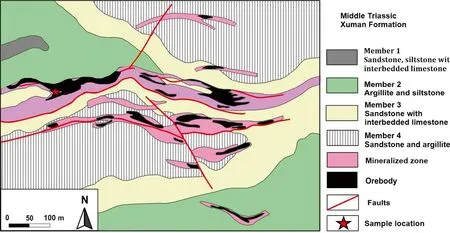
Fig.2 Geologic map of Yata deposit(modified after Zhang et al.2003)
The Yata deposit is hosted by the Middle Triassic Xuman Formation that is composed of siltstone,sandstone,argillaceous limestone,and shale.According to Tao et al.(1987),the Xuman Formation is divided into four members,based on the bedding thickness and grain size of the rocks.The main gold hosting strata are Member 1 and Member 2 that composed of sandstone with interbedded limestone,and sandstone and argillite,respectively.The gold mineralization occurs mainly on the southern limb of the Huangchang anticline,extending about 3 km EW along strike(Su et al.2009).More than 40 orebodies with average gold grades from 1 to 5 g/t occur in a deposit(Han et al.1999),and the highest detected Au grade of bulk samples is 50.7 g/t from the M1(Zhang et al.2003).The M1 zone is 1,500 m long,40 to 60 m wide,and 200 m thick,with average gold grades varying from 1 to 3 g/t(Zhang et al.2003;Su et al.2009).The deposit is controlled by the regional EW-trending system of folds and fractures,where the main are Bajin-Huangxin and Xinluoai anticlines and Weile syncline(Tao et al.1987;Zhang et al.2003).
Alteration is represented by decarbonatization,silicif ication,sulf idation,and argillization of wall-rocks and is well described in Zhang et al.(2003).Altered rocks extend far away from faults and fractures along more reactive or permeable clastic strata of calcareous shale and siltstone.Unaltered rocks contain quartz,biotite,ferroan dolomite,illite,calcite,and minor f ine-grained diagenetic pyrite(Ashley et al.1991).The ore minerals are arsenian pyrite,arsenopyrite,stibnite,marcasite,orpiment,and realgar.Ganguemineralsincludequartz,dolomite,calcite,and clay minerals.Stibnite(Fig.5a)typically occurs in association with realgar and quartz across gold orebodies and has euhedral crystals f illing fractures(Tao et al.1987;Zhang et al.2003).The ore-forming f luid of the Yata deposit is characterized by low temperature(144-263°C)and low to moderatesalinity(from 0.21 wt.%to 7.43 wt.%NaCleq.;Li et al.2019).Hydrothermal quartz veins that contained variably realgar and stibnite in the Yata deposits have obtained Rb-Sr isochron age of 148 Ma(Jin 2017).
2.3 The Badu Au and Sb deposit
The Badu Au and Sb deposit located in Guanxi province,near the Youjiang regional fault(Fig.3)at the western section of Badu anticline and have proven gold reserve of 35 t,with an average gold grade of 3 g/t(Gao 2018;Yan et al.2018).The Badu anticline and Xilin-Baise fault-fold zones are the main structures of the deposit.
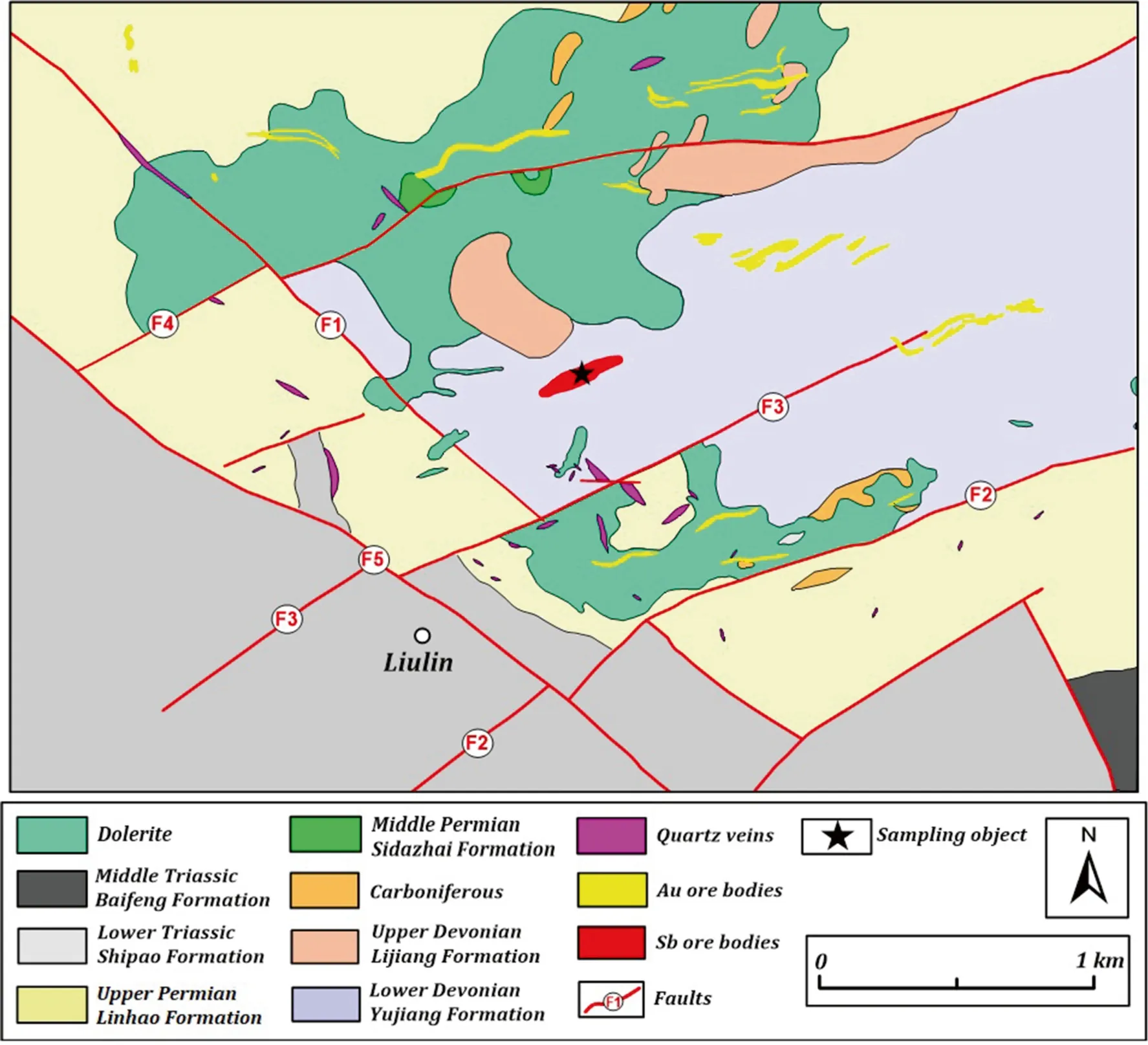
Fig.3 Geologic map of Badu deposit(modified after Gao et al.2021)
The sedimentary rocks are represented by the lower Devonian Yujiang Formation(composed of mudstone and siltstone),the Upper Devonian Liujiang Formation(comprises the interbedded sequence of silicalites and tuff with lenses of banded limestone),the Carboniferous mudstone and silicalites,the Permian rocks(interbedded limestone and silicalites,with local dolomitization and marbleization,mudstone,argillaceous sandstone,tuff intercalated with siliceous mudstone),and the lower and middle Triassic rocks(sandstone,siltstone,and mudstone;Gao 2018).
The diabase units in the Badu anticline occur as a series of arc-shaped E-W trending intrusions.The unmetamorphosed early-stage sills were emplaced into Upper Palaeozoic carbonateand clastic rocksand crop out over an area up to 20 km long and 0.5-2.0 km wide.Late-stage diabase sills are also common within sedimentary units from Devonian and Carboniferous mudstones to Lower Triassic carbonates(Qiu et al.2017).
There are seven orebodies in a deposit that occurs as veins and tabular-shaped bodies.Most orebodies are NEEtrending with minor NW-trending and are controlled by the secondary fault systems.Gold orebodies are 20-70 m long and several meters to morethan ten meterswidely occur in argillaceous siltstone and altered diabase and controlled by northeast and northwest striking faults.The wall-rock alteration is described by silicif ication,sulf idation,calcif ication,and argillization.Gold occursin arsenian pyriteand arsenopyrite crystals that widespread in averagely silicified rocks.Industrial importance has Sb mineralization that enriched in quartz veins and veinlets(Fig.5b,c).
There are two different ore hosting rocks in a deposit,including dolerite-hosted and mudstone-hosted. The weakly altered dolerite is mainly composed of plagioclase,clinopyroxene,minor titanite and ilmenite,trace apatite,and rare sulf idesand quartz,and ischaracterized by typical doleritic or poikilophitic texture with laths of plagioclase intergrown with clinopyroxene.Dolerite ore mineralization is represented by ankerite,sericite,pyrite,arsenopyrite,rutile,apatite,and minor basemetal sulf ides.Lateorestage minerals are represented by stibnite,realgar,cinnabar,and barite.Mudstone-hosted mineralization is characterized by pre-ore stage ankerite,framboidal and diagenetic pyrites;ore stage pyrite and arsenopyrite;and late ore stage stibnite,realgar,and orpiment.Fluid inclusion studies from quartz veins in altered diabase orebody are higher than in mudstone-hosted ore and show~300°C;with salinity between 5.7 wt.%and 17.5 wt.%NaCleq.(Li et al.2014).Quartz veins that typically associate with stibnite in mudstone-hosted ore show mineralization temperature between 150-280°C.In situ SIMSU-Th-Pb dating on hydrothermal rutile and monazite yielded well consistent ages of 141.7±5.8 Ma(2σ,MSWD=1.04)and 143±1.4 Ma(2σ,MSWD=1.5),respectively,which reliably represent the mineralization age of the Badu deposit(Gao 2018;Gao et al.2021).
2.4 The Qinglong Sb deposit
The giant Qinglong Sb deposit is in the northwestern part of the Youjiang Basin and contains eight ore blocks including, Dachang, Shuijingwan, Dishuiyan, Gulu,Houpo,Xishe,Sanwangping,and Heishanjing(Fig.4).Among them,the Dachang ore block is the main ore hosting block.The ore bodies are typically conf ined to anticline structures and controlled by NE or EW striking fault systems.The deposit comprisesdifferent hosted strata including,Middle Permian Maokou Formation,Upper Permian Emeishan f lood basalts,and the Longtan Formation.
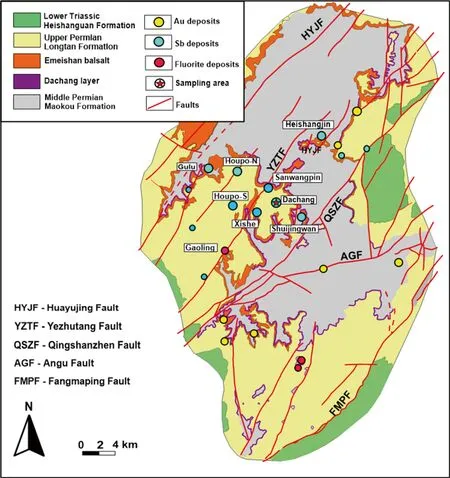
Fig.4 Geologic map of Qinglong deposit(modified after Chen et al.2018)
The shallow-water carbonate rocks of Maokou Formation are the base for the main ore-hosting Dachang block and the middle part rocks are represented by igneous rocks and silicified limestone and the upper part is dominated by tuff and carbonaceous mudstone.The Emeishan f lood basalt is tholeiitic and the Longtan Formation is composed of sandstone and shale(Chen et al.2014,2018).
Dachang ore block is the SE wing of the Bihengying anticline.The ore bodieshere usually have lamellar,quasilamellar,and lenticular forms and are divided into three units:lower,middle,and upper units(Chen et al.2018).Thehost rocksof the lower unit represented by argilliteand silicified limestone.The middle unit is dominated by tuff,basalt,altered and silicified limestone.Limestone is highly porous and may host quartz,stibnite,and f luorite.The upper unit iscomposed of tuff and carbonaceousmudstone.This unit is characterized by quartz,stibnite,and pyrite mineralization.The ore-bearing rocks are strongly altered,silicified,and locally brecciated.Early ore stage minerals are represented by Au bearing arsenian pyrite,pyrite,and quartz.That arsenian pyrite is very similar to the typical Carlin-typearsenian pyrite,with thecoreand rim structure.Gold mineralization with the gold grade up to 9.9 g/t developed in the Dachang layer(Chen et al.2018).The stibnite ore stage is characterized by stibnite,pyrite,jasperoid quartz,quartz,f luorite,and kaolinite(Fig.5d).Late ore stage minerals are quartz,calcite,orpiment,and realgar(Su et al.2015;Li et al.2019).Homogenization temperatures of f luid inclusions are characterized by low temperature and low-moderate salinity that range between 145-198°C and 0.18 wt.% to 7.22 wt.% NaCleq.,respectively(Liet al.2019).The Sm-Nd isotope system of stibnite bearing f luorite from Qinglong deposit corresponding to the isochron ages of 148±8 Ma and 142±16 Ma,suggesting late Jurassic time of ore mineralization(Peng et al.2003).
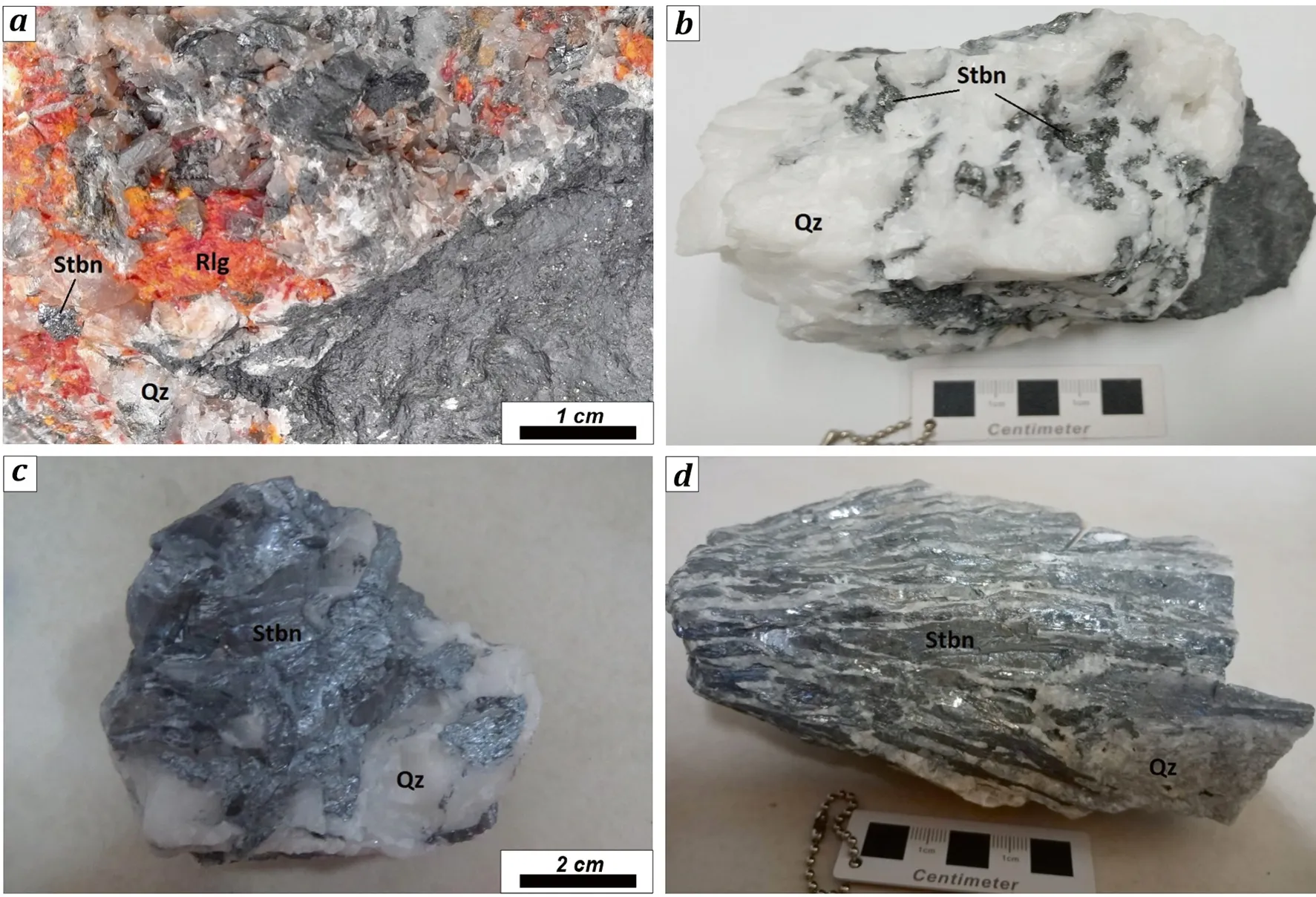
Fig.5 Hand specimen photos;optical microscope and SEM BSE images respectively:Yata deposit(a);Badu deposit(b;c);Qinglong deposit(d)
3 Sampling and analytical methods
Stibnite samples in association with realgar and orpiment in quartz or calcite veins were collected from three different deposits.At the Yata deposit,sampleswerecollected from the open pit.At the Badu deposit,samples were taken from underground tunnels in the mudstone-hosted zone.And at the Qinglong deposit,tunnel No.1 and drill core samples from the Dachang ore block were collected.All representative stibnite samples were separated using a binocular microscope and analyzed for trace element,S isotope,and stibnite bearing quartz used for the O isotope.Inductively coupled mass spectrometry(ICP-MS)technique,which is an accurate and sensitive tool with detection limits of parts-per-trillion analyzed detailed trace element characteristics in stibnite samples.After careful separation of pure stibnite from other minerals under a binocular microscope,samples were crushed with agate mortar(200 mesh)and weighed between 50-100 mg.Powdered samples later were dissolved in HNO3(w 5 mL)and placed on a hot plate(100°C)overnight.Solutions were subsequently diluted to a volume of 90 mL(1%HNO3).Trace elemental concentrations were determined on a Perkin Elmer Elan quadrupole ICP-MS.Chemical analyzes were carried out by the State Key Laboratory of Ore Deposit Geochemistry of the Institute of Geochemistry,Chinese Academy of Sciences.
Sulfur isotopic compositions were obtained from stibnite samples.Separated pure mineral grains were crushed with agate mortar(200 mesh)and weighed between 50-100 mg.The isotopic composition of sulfur expressed asδ34S unit,in permil(‰),relative to Vienna Canyon Diablo Troilite(V-CDT)standard,and its analytical precision is about±0.3‰.The isotopic compositions of minerals were analyzed at the State Key Laboratory of Ore Deposit Geochemistry of the Institute of Geochemistry,Chinese Academy of Sciences.
For oxygen isotope analysis,quartz separates were crushed to 200 mesh size and degassed at 250°C for about 2 h in Ni reaction vessels(Clayton and Mayeda 1963).Oxygen was produced by reacting 5-10 mg of quartz samples with BrF5and converted to CO2with a platinumcoated carbon rod.Oxygen isotopic compositions are expressed relative to Vienna Standard Mean Ocean Water(VSMOW)andδ18O values of ore-forming f luid were calculated from theδ18O values of quartz by using isotope fractionation factors(Clayton et al.1972).Oxygen isotopic compositions in quartz were determined using Thermo Finnigan MAT-253 Isotopic Mass Spectrometer at the Beijing Research Institute of Uranium Geology,China National Nuclear Corporation.
4 Results
4.1 Trace elements composition
Trace elements concentration in stibnite from three different deposits of the Youjiang Basin,including Yata Au and Badu Au-Sb,and Qinglong Sb deposits have been analyzed in this study.The As,Cu,Pb,V,Sr,Se,Ag,Te,Ba,Tl,Pb,and Bi elements are consistently concentrated within thestibnitein all examined samples.Thefull dataset is given in Appendix Iand Figs.6,7,8.The concentration of the elements can be high from thousands to hundreds of ppm,but most are typically tens to hundreds of ppm.A strong difference in element composition show As,Cu,and Pb between the deposits(Fig.6).
Stibnite from Badu Au-Sb deposit characterized by elevated trace elements composition including,Asranging between 5470 to 10,900 ppm,median at 7527 ppm(n=17);Cuvaries from 267 to 2770 ppm,with the median at 874 ppm(n=17);andPbconcentration from 1691 to 2910 ppm,with the median at 2341 ppm(n=17);other elements have lower contents in stibnite.Stibnite samples from the Yata Au deposit also have elevated concentration ofAs,with values from 479 to 1300 ppm,median at 737 ppm(n=8);Cuconcentration is ranging from 148 to 1481 ppm,with the mean concentration at 442 ppm(n=8);andPbis from 281 to 2010 ppm,with the median at 1241 ppm(n=8).The Qinglong Sb deposit is represented by much homogeneous stibnite chemistry compare to Badu and Yata deposits,with the lowest element composition.Accordingly,Qinglong stibnite shows the following composition:Asis ranging between 45 to 502 ppm,mean concentration is 242 ppm(n=10);Cuconcentration demonstrate values from 6 to 440 ppm,with the median at 74 ppm(n=10);andPbconcentration ranges between 6.3 to 118 ppm,median at 32 ppm(n=10)(Figs.8,9).
4.2 S isotopes
To investigate the source(s)of sulfur during the genesis of the Yata Au,Badu Au-Sb,and Qinglong Sb deposits,we analyzed stibnite samples.The complete isotopic dataset is provided in Appendix II and shown in Fig.10.The measured sulfur isotopic variation of sulf ides shows a wide range inδ34S and extends from-6.6‰to+17.4‰(Fig.10).In more details,Badu stibnite samples show enrichment of34S and theδ34S values display between+16.56‰to+17.45‰,with the median of+17‰(n=12);Yata stibnite samples haveδ34S values from+5.1‰to+6.8‰,median at+5.99‰(n=9);and Qinglong deposit stibniteδ34Svalues range between-6.6‰to-0.9‰,with the median at-3.48‰(n=26).
4.3 Oxygen isotopes
The oxygen isotopic composition of quartz may preserve a record of f luid history and is mainly inf luenced by the temperature and salinity of the f luid,as well as water-rock interaction(Lubben et al.2012).Detailedδ18O isotope studies for Yata and Qinglong deposits have been published earlier by Liet al.(2019),therefore,in thisstudy,we mainly accentuate in Badu deposit and compare it with the Yata and Qinglong depositsusing previous data(Appendix III;Fig.11).
Theδ18O values of mineralized quartz-stibnite veins of Badu deposit vary from+18.4‰to+20.1‰(Appendix III;Fig.11).The ore f luid temperature in the Badu deposit ranges between 150-300°C,with an average of 230°C(Appendix IV).Theδ18O values of the hydrothermal f luid are isotopically equilibrated with quartz(Matsuhisa et al.1979).Therefore,the oxygen isotopic composition of f luid was calculated using the measuredδ18O values of quartz and the homogenization temperature of f luid inclusions in this mineral.We used the oxygen isotope fractionation equation for the quartz-water system given by Clayton et al.(1972):1000 lnαQ-W=3.34(106 T-2)-3.31.

Fig.11 Variations in(a)δ18Oquartz between YT:Yata,BD:Badu,QL:Qinglong deposits and their calculated(b)δ18O f luid values.Also shown are the known ranges for the δ18O isotopic compositions in meteoric,magmatic,and metamorphic water,adapted from the data in Clayton et al.(1974)and Rollinson(1993)
5 Discussion
5.1 Implications from the Trace Elements in Stibnite
Results of the stibnite element chemistry allow us to recognize that stibnite from gold and antimony depositsof the Youjiang Basin tend to contain a common suite of elements,including As,Cu,Pb,V,Sr,Se,Ag,Te,Ba,Tl,Pb,and Bi(Figs.7,8).Among them,to distinguish various typesof stibnite mineralization between the Yata Au,Badu Au-Sb,and Qinglong Sb deposits,the As,Cu,and Pb have considered most diagnostic.
Noteworthy,As is the most abundant element in stibnite samples in all three deposits Fig.8.No visible As-bearing mineral inclusions were identified under the optical microscope and BSE SEM images(Fig.6),suggestively As3+substituted Sb3+mainly as a solid solution.Despite,different crystallochemical behavior and structures of As and Sb sulf ides,they are chemically analogous elements thus resulted extensive As/Sb substitution.Such high As concentration also occurs as a solid solution in stibnite crystals from the Carlin-type gold deposits of Nevada with 1,500 to 70,000 ppm As(Dickson et al.1975).Moreover,it isnoticed that As-rich stibnite isusually enriched in Cu and Pb,compared to As-poor stibnite.Bivariate plots of As/Cu(R2=0.57)and As/Pb (R2=0.69)have a positive correlation(Fig.9)and suggest that incorporating these elementsiscontrolled by asimilar processand that they are closely associated in stibnite.
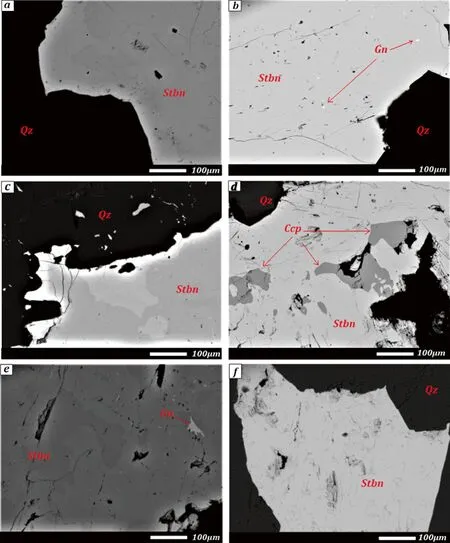
Fig.6 SEM-BSEimages of stibnite samples:a,b-Yata stibnite samples;c,d,e-Badu stibnite samples;f-Qinglong stibnite.Abbreviations:Qz-quartz;Sb-stibnite;Ccp-chalcopyrite;and Gn-galena
The Cu and Pb content relatively less than As,but still high compare to other elements in stibnites,and more enriched in Au and Au-Sb deposits than in Sb deposits(Fig.8).The relationships among the elements analyzed in stibnite have a positive correlation between Cu and Pb(R2=0.75)element pair(Fig.9).Suggestively,such dual inter elements positive correlation may indicate coupled incorporation in the stibnite crystal:Sb3+↔Cu++Pb2+(Fu et al.2020).Besides,BSE SEM images demonstrate Cu-bearing and Pb-bearing mineral inclusions in stibnite from Yata Au and Badu Au-Sb deposits(Fig.6;a,b,c,d,e),except stibnite from Qinglong(Fig.6;f).Therefore,Cu and Pb can exist as microscopic Cu-bearing and Pb-bearing mineral inclusions in stibnite,as well as structurally bound in the lattice.

Fig.7 Scatter plotsdemonstrate concentrationsof V,Sr,Te,Se,Bi,Ag,Tl,Ba,and Zn elements in stibnite determined by ICP-MS(all valuesin ppm)
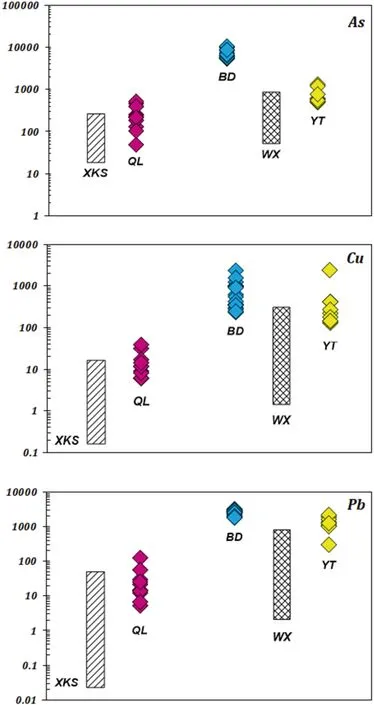
Fig.8 Scatter plotsshowing themean concentrationsof key elements in stibnite determined by ICP-MS(all values in ppm).YT:Yata Au deposit,BD:Badu Au-Sb deposit,QL:Qinglong Sb deposit.For comparative purposes plotted(As,Cu,Pb)previous data for XKS:Xikuangshan Sb deposit,WX:Woxi Sb-Au-W deposit(Fu et al.2020)
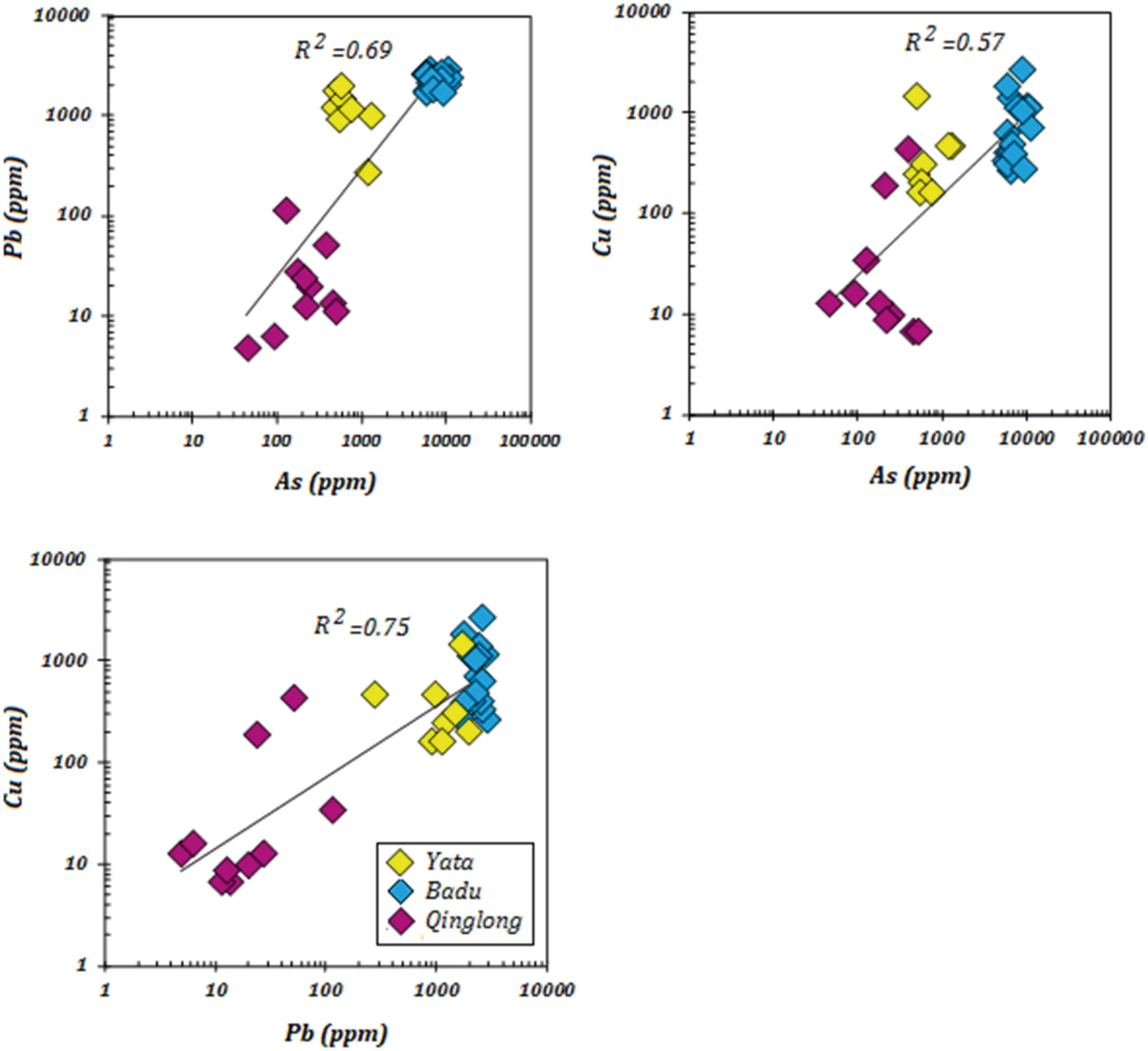
Fig.9 Correlation plots between(a)As vs.Pb;(b)As vs.Cu;and(c)Cu vs.Pb elements in stibnite detected by ICP-MS
Although,some maf ic rocks occur in the Badu Au-Sb deposit;Qinglong Sb deposit is partially hosted by Emeishan basalts;and the hidden granitic intrusions recognized deep interior of the Youjiang Basin(Zhou 1993),undetectable or very low Rb,Cs,and Cr concentrations imply no relationship to granite or volcanic related ore f luids in the deposits.In contrast,Sr and V concentrations may indicate the result of the f luid and sedimentary rocks interaction(Jiang et al.1999).
The character of stibnite trace element chemistry determines the obvious difference between the studied deposits.Accordingly,the Au and Au-Sb deposits are much enriched in triple elements association including,As,Cu,and Pb,and their concentration variability may have considered as important ore deposit type(Au or Sb)deciphering tool.
5.2 Possible Sulfur Sources
The sulf ide minerals in most Au and Sb deposits of the Youjiang Basin are characterized by pyrite,stibnite,realgar,orpiment minerals,which typically form at relatively low-temperature,lowfO2,and pH-acidic to neutral conditions.Under these conditions,fractionation between aqueous sulfur and sulf ides is minimal,thus the measured δ34Sin sulf idesisapproximately equal to or slightly higher than the bulk sulfur isotope compositions of sulf ide-precipitating ore f luids(δ34Spyrite-fluid=0‰-1.5‰;Kajiwara and Krouse 1971;Ohmoto 1972;Ohmoto and Rye 1979).In Carlin-type gold and antimony deposits of the basin,the δ34S values of ore pyrite are higher than those of stibnite(Hu et al.2002;Chen et.2018;Yan et al.2018).This is consistent with that34S enrichment follows the general trend SO2-4>SO2-3>SOox>SO2-(Bachinski 1969;Seal 2006),and indicates that the isotopic equilibrium between sulf ide and H2S was reached.
Theδ34Svalues of stibnite from Yata Au,Badu Au-Sb,and Qinglong Sb deposits have a wide range from-6.6‰to+17.4‰,demonstrating both depletion and enrichment of Sisotopes(Fig.10).Among them,the Badu Au-Sb deposit exhibits the heavyδ34S values(+16.54‰to+17.45‰)and is similar to diagenetic pyrite in the host rock(+13‰to+22‰;Li 2019).Such elevated sulfur values preclude any possibility of the mantle-derived source(from 0‰to+3‰;Chaussidon et al.1989),implying sedimentary sulfur source,originated suggestively via f luid-rock interaction and dissolution of diagenetic pyrite.Negative sulfur values of stibnite samples from the Qinglong Sb deposit characterized by-6.6‰to-0.9‰(Fig.10).Since the main host rock at Qinglong deposit is Upper Permian Emeishan f lood basalts,then,the interaction between ore f luids and basaltic rocks suggestively produced sulf ides with depletedδ34S values.The meteoric water might have occurred during ore mineralization and also resulted in enrichment of32S in the oreforming f luid.Theδ34Svalues of stibnite from Yata(+5.1‰to+6.8‰)are between those of the stibnite from the Badu deposit(16.54‰to 17.45‰)and those of the stibnite from the Qinglong deposit(-6.6‰to-0.9‰).Figure 10 shows thatδ34S values of the Yata stibnite similar to diagenetic pyrite(0‰to+5‰;Hu et al.2002)in the host rock,also suggesting a sedimentary sulfur source.

Fig.10 Histogram ofδ34S values in stibnite from YT:Yata,BD:Badu,QL:Qinglong deposits
The possible effect of the basin formation water,which is typically characterized by the heavy sulfur isotopes,because of abundant bitumen and organic components,may result from sulfate reduction to H2S(Hu et al.2002;Chen et al.2015).Sedimentary wall-rocks at Yata Au,Badu Au-Sb,and partially Qinglong Sb deposits represented by Devonian to Triassic strata and the seawater sulfate during that period range between+30‰to+12‰(Holse et al.1997).The nature of the ore f luids mainly characterized by low-moderate temperatures,with H2O,CO2,and hydrocarbon components,similar to basinal f luids in the Youjiang Basin(Wang et al.2003;Gu et al.2010,2012).Consequently,transportation and interaction within the host rocks at different deposits possibly resulted in dissimilar sulfur isotopes in each deposit.
However,recent in-situ sulfur isotope investigations carried out in several Carlin-type gold deposits of the Youjiang Basin suggest that magma was probably an important source of the ore-forming f luids in the basin(Hu et al.2017).For example,in the Shuiyindong gold deposit,theδ34Svaluesfor orestagepyriterangefrom 2.6‰to 1.5‰(Hou et al.2016),and late ore stage sulf ides,such as realgar,orpiment,and stibnite range from 0.5‰to 5.3‰(Tan et al.2015).Suchδ34Svalues are very close to those of mantle sulfur(0‰±3‰;Chaussidon et al.1989),suggesting a magmatic sulfur source.Also,Yan et al.(2018)noted that theδ34S values of ore stage pyrite from the Lannigou gold deposit variesbetween 1.1‰to 18.1‰,and the late ore stage minerals,as realgar,cinnabar,and stibnite range from 10.6‰ to 13.2‰.The author explained that the ore-bearing f luid was likely formed by the mixing of magmatic and crustal f luids.Where sulfur in the crustal f luid is suggestively derived from the sedimentary pyrite of the host rocks via f luid-rock interaction and sulfur in the magmatic f luid have mantle-derivedδ34S source.
Besides,Chen et al.(2015)reported a large variation of δ34S values of arsenopyrites from the Carlin-type gold deposits of the Youjiang Basin and suggested sedimentary sulfur sources.And differentδ34S values between the deposits are a possible result of the transportation of basin formation water to the carbonate platform and variable f luid-rock interaction and meteoric water dilution.
Thus,the distinct sulfur source(s)of the gold and antimony deposits in the Youjiang Basin is still under debate and further analytical works are required to evaluate these possibilities.
5.3 Possible Oxygen Source
A variety of factors may introduce the oxygen isotope f luctuation in quartz,including f luid temperature and salinity variations,f luid boiling or immiscibility,and f luidrock interaction(Lubben et al.2012).The fractionation of oxygen isotopes between mineral and f luid is inversely related to temperature,and the presence of ionic salts will also affect the fractionation between water and mineral(Hoefs 1997).However,f luid inclusion microthermometry indicates that temperature and salinity of the ore f luid remained nearly constant across the stibnite ore zones,and f luid inclusion analyses have not identified f luid boiling evidence in all three deposits.The temperature variation of~150 to 250°C across the deposits,recorded by f luid inclusions,would cause variationsin quartz oxygen isotope values of~4‰(Zheng 1993),which cannot explain the total variation in quartz oxygen isotope compositions.Thus,signif icant variationsin f luid temperature or salinity,and the occurrence of f luid boiling seem highly unlikely to be the main cause of the variations in quartz oxygen isotope compositions measured across the deposits.
Another source for the oxygen isotope diversity of orestagequartz may ref lect the interaction between a relatively δ18O depleted ore f luid andδ18O enriched carbonate host rock,as f luids migrated along different f luid-f low pathways(Rye and Bradbury 1988;Lubben et al.2012).The origin of theδ18Oenrichment trend most likely is the result of the loss of an undetermined amount of H2O vapor from the system during the ascent of the f luids.The loss ofδ18Odepleted H2O vapor will have the effect of enriching the remaining f luid inδ18O.During decarbonatization that occurs in all three deposits,oxygen likely released from sedimentary host rocks and contributes to the oxygen isotope composition of quartz precipitating from f luids f lowing through these rocks(Lubben et al.2012),causing the formation of quartz with highδ18O values.
For example,in the Badu deposit,calculatedδ18OH2Ovary from+8.52‰to+10.22‰(Fig.11;~200°C).Obtained initialδ18OH2Oresultspropose two possibleδ18O origins:(1)magmatic water that characterized by uniform δ18O values between+5.5‰to+10‰,or(2)or metamorphic water,with wide range values from+2‰to+25‰(Clayton et al.1974).It might have suggested that the initial f luid in Badu deposit with the lowδ18O isotopic composition,raised to more shallow horizons and interacted with the sedimentary host rocks with a typical high isotopic composition(δ18OVSMOW=24‰-27‰;Vaughan et al.2016).Besides,the trend towardδ18O enrichment at shallower levels and lower temperatures indicates that signif icant mixing with shallow meteoric water did not occur(Madu et al.1990).A similar scenario likely explains the highδ18O isotopic composition of ore related quartz in the Yata deposit(δ18OQfrom+18.98‰to+30.95‰;δ18OH2Ofrom+7.70‰to+14.87‰;Fig.11),whereas,the ore is mainly hosted by sedimentary rocks that characterized by highδ18Oisotopic composition as mentioned before.
In contrast,at the Qinglong depositδ18O isotopic composition of the ore-related quartz and calculated f luid differ from the above two deposits.The deposit is hosted by Dachang Formation that is dominated by Emeishan basalt,or the equivalent tuff,and located along the f luid conduit between the Dachang and Maokou Formations.Theδ18OQranges from+4.58‰to+22.38‰and δ18OH2Ofrom-11.36‰to+8.74‰(Fig.9).Such values indicate f luids would subsequently becomeδ18O depleted as a relatively δ18O-enriched country rock(Maokou Formation)became increasingly unavailable for reaction along f luid-f low pathways and Emeishan f lood basalts and tuffs of the Dachang Formation generated decrease ofδ18O values;as well as considerable meteoric water dilution,might have occurred that also might result fromδ18O decrease.
6 Genetic model for Sb mineralization at Youjiang Basin
Youjiang Basin is an important region comprising many Carlin-type Au and Sb deposits.Their spatial-temporal distribution is related to the unique geology of the basin.Three types of Sb occurrences can be distinguished based on geologic characteristics,economic metals,and mineral associationsin the Youjiang Basin including,preferentially Sb mineralization like Qinglong deposit,southwest of Guizhou.Thesecond typehasaspatial association with the gold deposit,but formed independent Sb mineralization,resembling the Badu deposit,in the northwest of Guangxi.Besides,Sb generally formed as an accompanying element in the Carlin-type gold deposit,and stibnite occurred as euhedral crystalsf illing theopen spaceand faultsin thelate stage of gold mineralization,similar to the Yata deposit.The trace element composition of stibnites reveals As,Cu,and Pb elements as most diagnostic between the deposits.The relatively high content of these elements detected in Au-associated deposits of the Youjiang Basin,while the Sb-only deposit contains very low elements concentration.Similar characteristics are also mentioned in the Woxi Au-Sb and Xikuangshan Sb deposits of Xiangzhong Basin,South China,with the elevated concentration of As,Cu,and Pb in the Woxi Au-Sb deposit(Fu et al.2020).Therefore,As,Cu,and Pb triple elements association is suggested as an important Sb occurrence deciphering tool in South China low-temperature deposits.
Preliminary geochronological works revealed the Sb deposits or Sb mineralization in the Youjiang Basin are formed at 148 to 134 Ma,suggesting they shared a similar setting,and are contemporaneous with Carlin-type gold mineralization.For example,f luorite intergrown with stibnite in the Qinglong deposit has yielded Sm-Nd isochron age of 148 Ma(Peng et al.2003),hydrothermal quartz vein that contained variably realgar and stibnite in the Yata deposits have obtained Rb-Sr isochron age of 148 Ma(Jin 2017).Similarly,hydrothermal rutile and monazite in the Badu gold deposits have also yielded U-Th-Pb agesof 144 to 141 Ma(Gao et al.2021).This age ranges coincide with the Yanshanian tectonomagmatic event in South China,from 180-87 Ma,peak at 158 Ma(Wang et al.2012;Hu et al.2017),that triggered the largescale and high f luid f luxes in Youjiang Basin,as well as in other regions of the South China metallogenic domain,such as Sb mineralization in Xiangzhong Basin(Hu et al.2017).
Generally,variations in the trace element composition of sulf ides and theδ18O isotopic values of f luid may be caused by changesin physicochemical f luid parameters,the availability of complex-forming ligands,boiling,aswell as f luid-wall rock interaction(Huston et al.1995;Lubben et al.2012;Revan et al.2014;Wohlgemuth-Ueberwasser et al.2015;Keith et al.2016).
In the Qinglong deposit,previous workers determined salinities of 0.18 wt.%to 7.22 wt.%NaCleq.for inclusions in stibnite and intergrown quartz with homogenization temperatures ranging from~145-198°C and CO2-minor(Chen et al.2018;Li et al.2019).In the Yata deposit,the salinities similarly range from 0.21 wt.%to 7.43 wt.%NaCleq., with homogenization temperatures ranging from~144-263°C and CO2-rich(Li et al.2019).The Badu deposit is also characterized by low-moderate f luid inclusions homogenization temperatures~150-280°C;CO2-rich.From this,the ore-forming f luid of the Yata,Badu,and Qinglong deposits characterized by low-moderate temperature and moderate salinity and were stable during ore deposition(Chen et al.2018;Li et al.2014,2019).The hydrothermal transport of Cu and Pb is very sensitive to boiling,which because of metal deposition,sharply reduces the concentrations of metals in the aqueous phase(Simmons and Browne 2006),but there is no boiling among the deposits noticed.
According to Wang et al.(2003),f luids f low from the basin to the platform had taken place in the Youjiang Basin.The f luids migrated laterally and vertically through the weak horizons,faults,fractures,and paleokarst.The initialδ18O values of f luids in Badu and Yata deposits are suggestively similar indicating magmatic or metamorphic origin,however,in Qinglong deposit it is more like meteoric water.Moreover,the Qinglong deposit is the best example for the f luid lateral migration,located in the platform,mainly hosted by Emeishan f lood basalts and tuff,and adjacent to the primary f luid conduit.However,the Badu and Yata deposits are mainly hosted by sedimentary rocks that are rich in carbonate minerals,f luidrock interaction caused decarbonatization and consequent δ18O enrichment,and elevated elements composition,regardless of their source,while in Qinglong deposit,f luid path,less suffered host rock(basalt,tuff)inf luence,and meteoric water dilution suggestively resulted fromδ18O and trace elements decrease.Therefore,ongoing f luid circulation,meteoric water,and lesswall rock inf luence likely played a crucial role in poor element concentration in the Qinglong deposit.
7 Conclusion
We used trace elements,S isotope studies of stibnite to characterize Sb occurrence in Au,Au-Sb,and Sb deposits of the Youjiang Basin.
1. The trace element composition of the stibnite samples from three different deposits has diverse element compositions.To distinguish the various stibnite occurrences Cu,Pb,and As have been recognized as most diagnostic.The Au and Au-Sb deposits are typically enriched in Cu,Pb,and As,while Sb deposits have very low concentrations.
2. The initial ore f luid most likely has magmatic or metamorphic origin in Badu Au-Sb and Yata Au deposits,and the water-rock interaction played an important role in these deposits’formation.However,in the Qinglong deposit,less water-rock inf luence and meteoric water dilution played a more important role.
3. Different lithology,f luid-rock interaction,f luid pathway,f luid f low,and meteoric water dilution were crucial during Sb occurrence in Au and Sb deposits of the Youjiang Basin.
AcknowledgementsThis research was funded by the National 973 Program of China(2014CB440906).We sincere thanks Yata,Badu and Qinglong Mining Companies for f ieldwork support.We are especially grateful to Dong Shaohua,Hu Jing and Jing Gu for their assictence in SEM,ICP-MSand S isotope analysis,respectively.
Declarations
Conf lict of interestThe authors declare that there is no conf lict of interest.
- Acta Geochimica的其它文章
- Correction to:Variations of methane stable isotopic values from an Alpine peatland on the eastern Qinghai-Tibetan Plateau
- Bicarbonate use and carbon dioxide concentrating mechanisms in photosynthetic organisms
- The possible source of uranium mineralization in felsic volcanic rocks,Eastern Desert,Egypt of the Arabian-Nubian Shield:Constraints from whole-rock geochemistry and spectrometric prospection
- Dissolved organic carbon concentration and its seasonal variation in the Huguangyan Maar Lake of Southern China
- Geochemistry and provenance of the lower-middle pliocene cheleken formation,Iran
- Geochemistry,geochronology,and zircon Hf isotopic compositions of felsite porphyry in Xiangshan uranium oref ield and its geological implication

